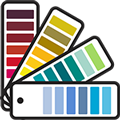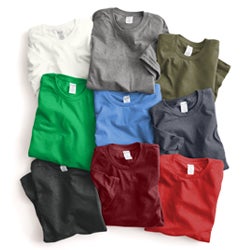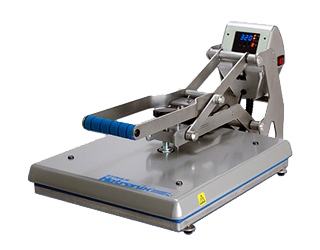DTG vs DTF: Is Direct to Garment Dead?
Browse Video Categories
Transfer Application | Artwork & Apparel | Easy View Tutorials | Webinars | Ordering Tips | Business | Heat Presses
Hey Friends, Dave here from Transfer Express and today, I want to shed some light on the differences between Direct to Garment (or DTG) and Direct to Film (also known as DTF) to help you decide which one is right for you.
While both are crazy cool inkjet-based digital printing technologies, there’s a few differences in capabilities to keep in mind when you’re planning to invest in one of these for your business, so let’s dive in!
Starting off, let’s chat about direct to garment. First brought to market in the early 2000’s, but it wasn’t really commercially viable or common to see used until a decade later. Direct to garment printing allows for printing full color images and extreme detail on t-shirts all without the need for color separations to a ton of screens for screen printing, and the hassle with registering all those colors- making full color artwork more affordable for low quantities. Of course, direct to garment machines print much slower than the high-efficiency of screen-printing presses and require quite a few chemicals and steps to finish a t-shirt; more on that in a minute.
Direct to Film or DTF has taken the apparel decorating industry by storm. Exploding in popularity after 2020, helping fuel the growth of the industry as a whole and allowing a cost-effective option for decorators just starting out. Direct to film printing uses the same principles as direct to garment, but instead of printing inks directly to the t-shirt fabric, inks are printed on a plastic carrier to then be heat applied to the garment.
There’s some pros and cons to each method, so let’s break them down:
First with DTG: of course, you have full color printing capabilities in any quantity. Direct to garment inks are durable and feel great on the garment, almost like a soft-hand screen print. You can have images fade away into the garment with soft edges and without screens and setup, personalization is easier than screen printing. With white printing as an under base, you can have vibrant color and opaque prints on a variety of fabric colors- light or dark.
The downsides, start with cost- direct to garment printers are a hefty investment, and for the most part, you’re limited to 100% cotton garments. Sure, there are solutions for printing on polyester now, but if you’re like most decorators, you don’t necessarily have 6 figures to drop on a printer capable of printing on those synthetic fibers. Another downside- time. Most commercial direct to garment printers max out at one shirt per two minutes. That’s print time, not accounting for loading or unloading t-shirts. Of course, there’s faster printers, but those come at premium pricing. Then, you have to have the chemical pre-treatment to allow the inks to bond to the fabric, adding additional steps to the process. After printing, you’ll need to cure the print- either with a heat press, or a commercial garment dryer, so with added equipment, you’re taking up more space. With owning a DTG printer yourself you have to take into consideration stocking supplies and regular maintenance to keep your machine running smooth- otherwise your print quality may suffer. Lastly, if you don’t know rip software, you’ll have to learn. This software tweaks the settings for taking your image from a computer screen to a vibrant print that looks great.
So, let’s shift over and look at direct to film. Again, we have full color capabilities, incredible detail and a durable print on the garment that feels lighter than most heat transfers- maybe not quite as light of hand feel on the garment as DTG, but close. While you can’t fade to the garment color, you still have a white base layer printed under your artwork for opaque prints with vibrant colors regardless of the fabric color. And the big benefit: direct to film prints on cotton, polyester, blended garments like 50/50’s and triblends along with spandex. DTF prints quicker than DTG, and typically applies to the garment with a heat press in just 15 seconds- like our UltraColor Max™ transfers here at Stahls' and Transfer Express.
The downsides of direct to film start with the print capabilities of not being able to fade to the garment- you need adhesive behind the inks, and without it, the print won’t stick, so you’re limited to hard edges. The same as with direct to garment, if you plan to own a printer, you’ll need to stock supplies and prepare for maintenance- while theres no pretreatment required, you’ll still need a methods to melt the adhesive and have proper ventilation to your space. We put together a video with a deep dive into DTF printing and everything you should know before investing here. One of which is replacement parts. With DTF still being relatively new, the market, replacement parts and information on how to fix machines is a little hard to find. Keep that in mind when shopping around and see if there’s dedicated customer service you can call for help before putting all your eggs into one basket.
Of course purchasing pre-made DTF transfers is incredibly affordable, just 6 cents a square inch from us here at Transfer Express, and without the upfront investment into machines it’s really an easy and low risk way to integrate DTF capabilities into your business. The only equipment you need is a heat press to apply those prints to apparel. It’s an easy step before diving in head first. You may even find you can maintain those profit margins without the need for added equipment.
Of course, if you do want to try out DTF for yourself we’d be happy to send you some free samples- we’ll even cover shipping. Get your free sample pack.
Now, be sure you’re subscribed to the Transfer Express YouTube page to stay up to date on all of the helpful t-shirt printing tips, tricks, inspiration and education that we’re dropping every single week. Until next time, I’m Dave, happy pressing!



















